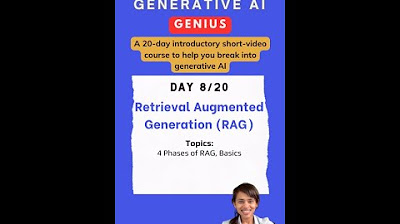Retrieval Augmented Generation - Neural NebulAI Episode 9
Summary
TLDRThis episode explores retrieval augmented generation (RAG), a technique to enhance large language models' context with relevant external information for more accurate responses. It breaks down RAG architecture and discusses techniques like prompt engineering for natural language to SQL translation that allow querying non-vector data stores. It also covers vector storage fundamentals like optimal embedding models and vector sizes for performance and accuracy. The strengths of RAG include rapid proof of concept development, while challenges involve planning contextual data retrieval and updates. Overall, RAG combines the strengths of neural networks with robust data retrieval.
Takeaways
- 😊 Retrieval augmented generation (RAG) enhances LLMs with external contextual information during inference.
- 🔎 RAG retrieves relevant information from documents to provide context to LLMs.
- 💡 RAG allows expanding context beyond LLM limitations in a cost effective way.
- 📚 Manual implementation of RAG builds deeper understanding compared to abstraction libraries.
- 😮 Start simple - use Kendra for quick proofs of concept to understand data and access patterns.
- 📊 Telemetry for user requests, retrievers and LLMs enables accuracy and performance optimization.
- 🔍 Choosing optimal storage and indexes depends on data structure, query access patterns and updates.
- ⬆️ Smaller embedding vectors currently provide better semantic search than larger ones.
- 🚦 Order of operations - get a usable prototype, then focus on optimizing based on real user data.
- 👍 RAG's speed and expandable context make it an essential technique to evaluate.
Q & A
What is retrieval augmented generation (RAG)?
-RAG is the ability to enhance an LLM's context through external information at inference time. This allows the LLM to generate more accurate and relevant responses by supplementing its existing knowledge.
What are some benefits of using RAG?
-Benefits of RAG include lower cost compared to fine-tuning models, ability to quickly update information by modifying the external data source, and flexibility to combine semantic and non-semantic retrieval techniques.
What type of external data can be used with RAG?
-Many types of external data can be used with RAG including structured data like CSVs or databases as well as unstructured data that can be embedded like documents or webpages.
What are some best practices when implementing RAG?
-Best practices include optimizing retrieval, carefully selecting the chunks of data to return, using clear and annotated prompts, and avoiding overloading the context window with too much irrelevant information.
How can embeddings be used with RAG?
-Embeddings allow unstructured text data to be represented as numeric vectors that can be efficiently searched. Tools like Cohere or Hugging Face can generate quality embeddings optimized for semantic search.
What are some strengths of Kendra for RAG?
-Kendra simplifies RAG by automatically handling data indexing, embeddings, retrieval APIs, and more. This makes it fast to get started even though it offers less customization.
What indexing algorithms work well for RAG?
-Approximate nearest neighbor algorithms like HNSW often provide the best performance for semantic similarity search used in RAG.
How can PostgreSQL be used for RAG?
-The PostgreSQL extension PG Vector enables efficient vector similarity search within PostgreSQL databases, providing a SQL interface for retrieval.
What data should be considered when choosing a vector store?
-The schema, query patterns, size, rate of change and other statistics about the data should drive whether something like PG Vector, MongoDB or a dedicated store like Pinecone is appropriate.
How can RAG systems be optimized?
-Continuous telemetry around query performance, accuracy, and user satisfaction can identify areas to optimize including prompts, chunking strategies, indexes, and more.
Outlines

This section is available to paid users only. Please upgrade to access this part.
Upgrade NowMindmap

This section is available to paid users only. Please upgrade to access this part.
Upgrade NowKeywords

This section is available to paid users only. Please upgrade to access this part.
Upgrade NowHighlights

This section is available to paid users only. Please upgrade to access this part.
Upgrade NowTranscripts

This section is available to paid users only. Please upgrade to access this part.
Upgrade NowBrowse More Related Video

W2 5 Retrieval Augmented Generation RAG

[RAG Series #1] Hanya 10 menit paham bagaimana konsep dibalik Retrieval Augmented Generation (RAG)

Build your own RAG (retrieval augmented generation) AI Chatbot using Python | Simple walkthrough

What is Agentic RAG?

Introduction to Generative AI (Day 7/20) #largelanguagemodels #genai

RAG vs. CAG: Solving Knowledge Gaps in AI Models
5.0 / 5 (0 votes)